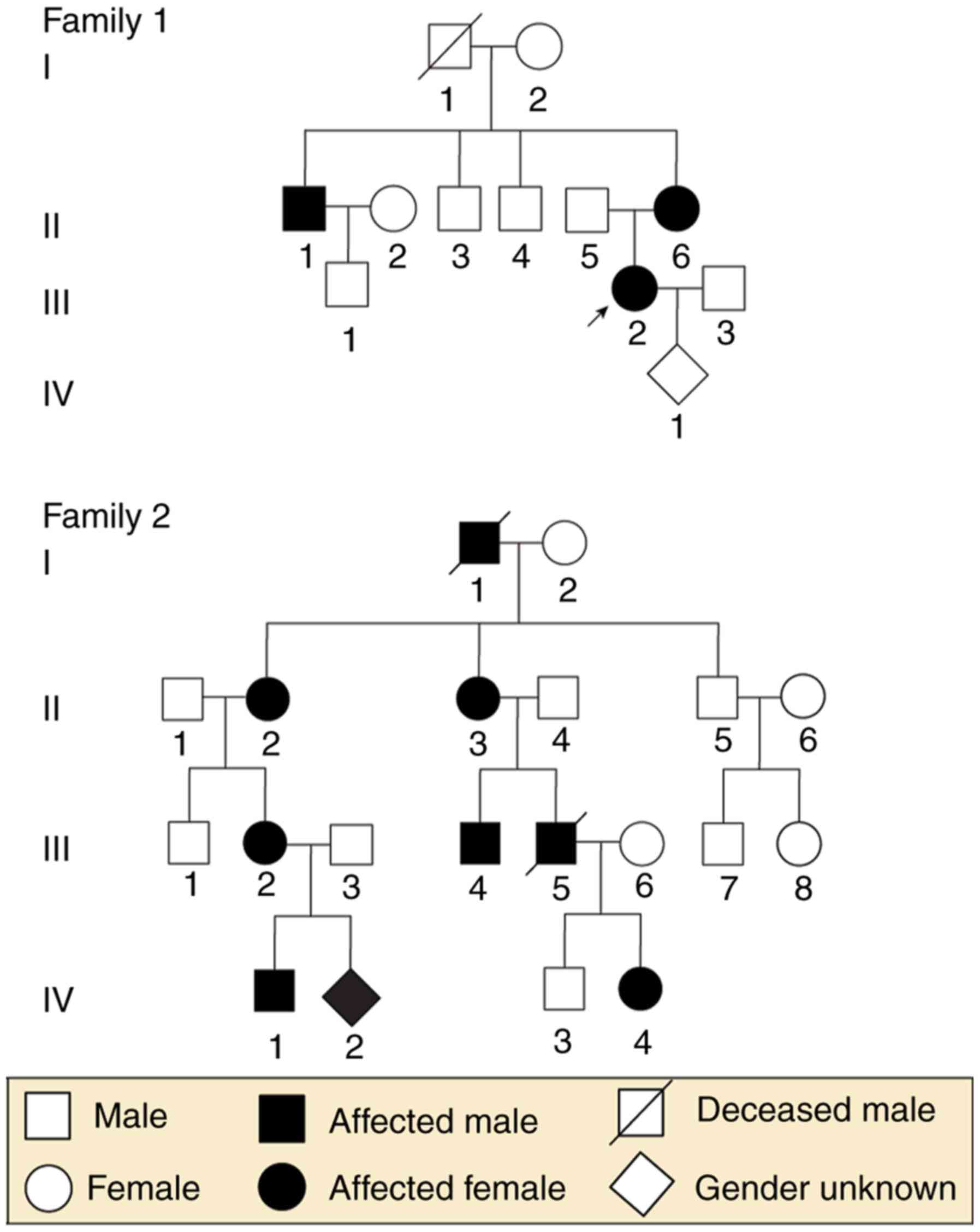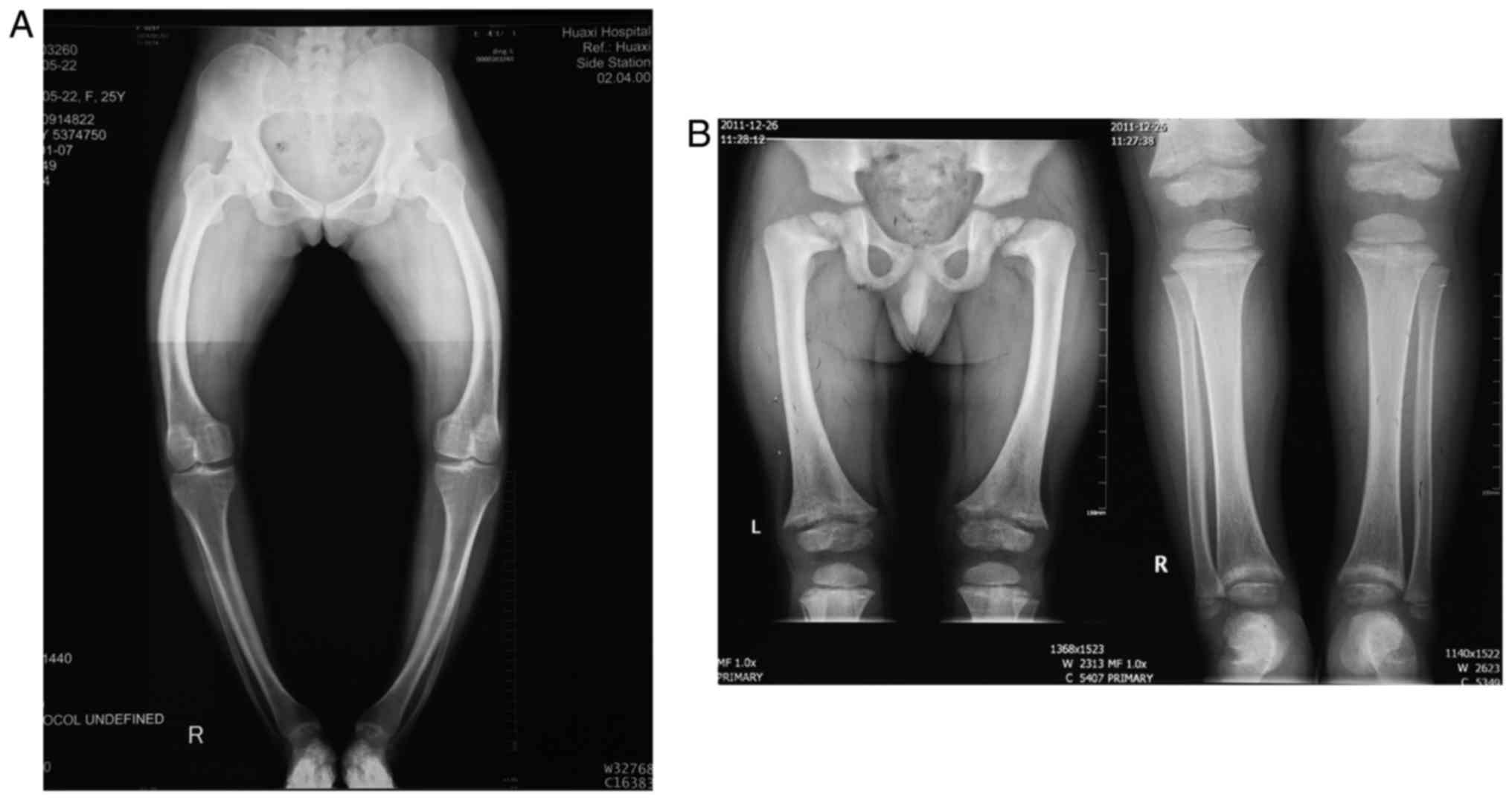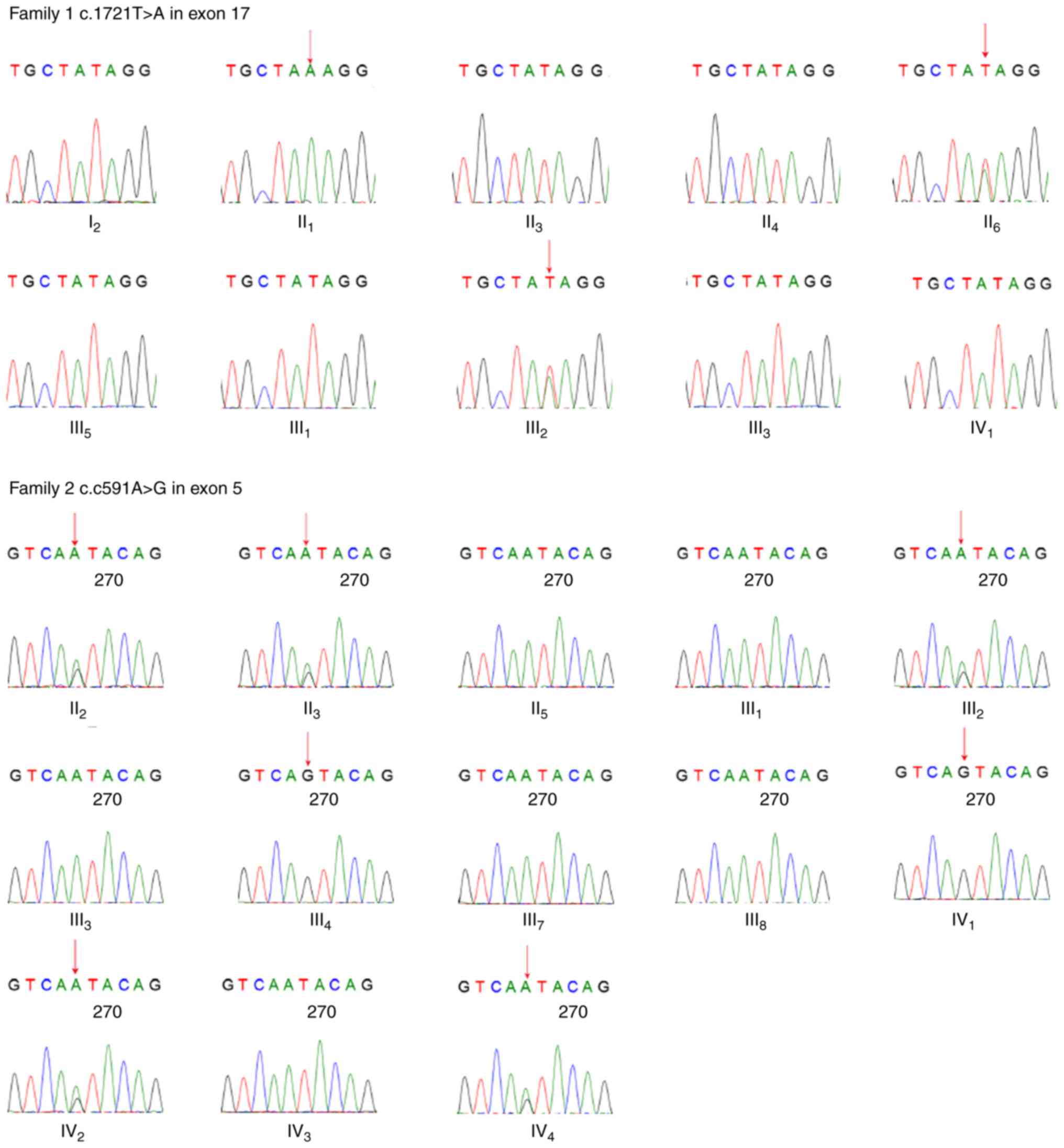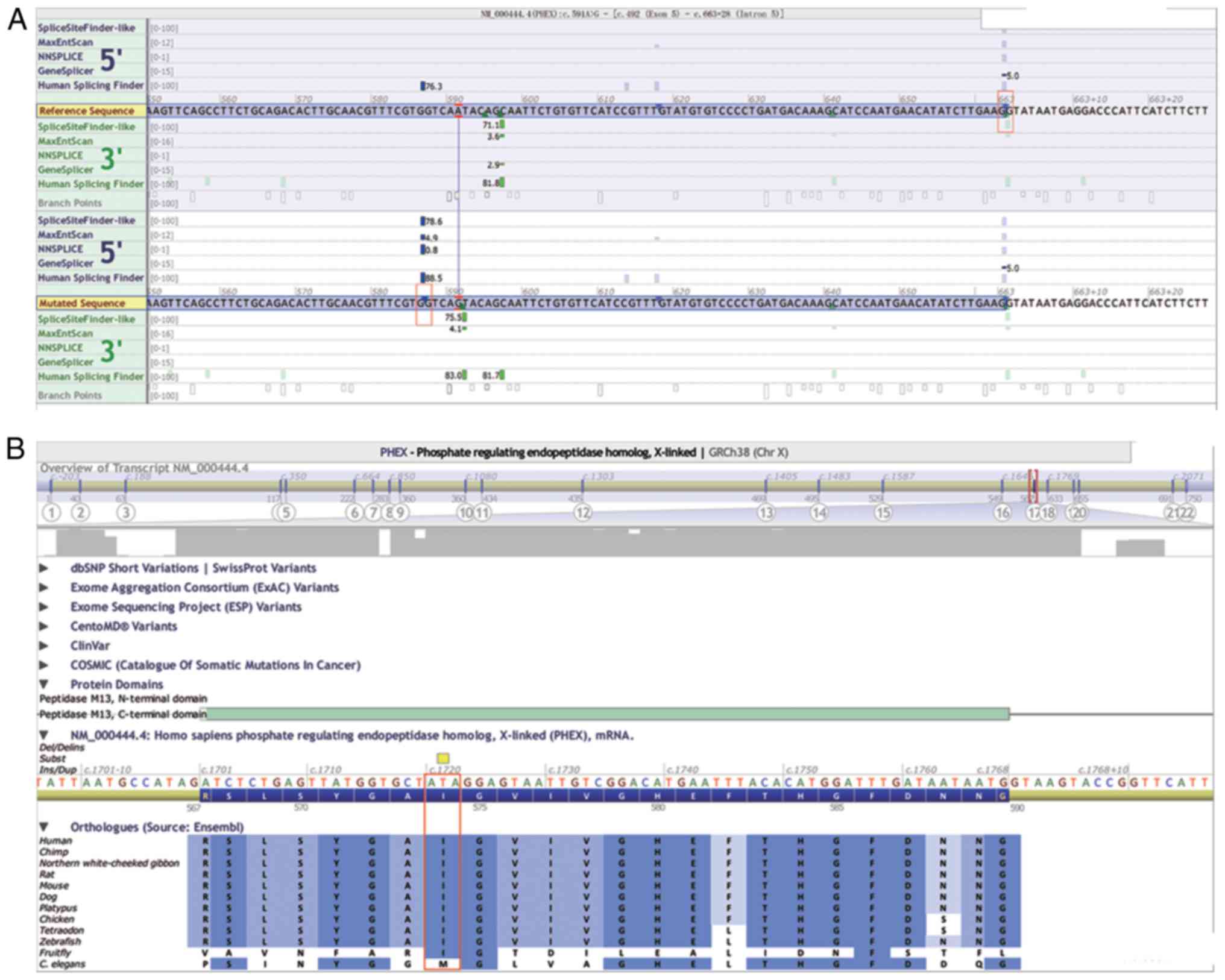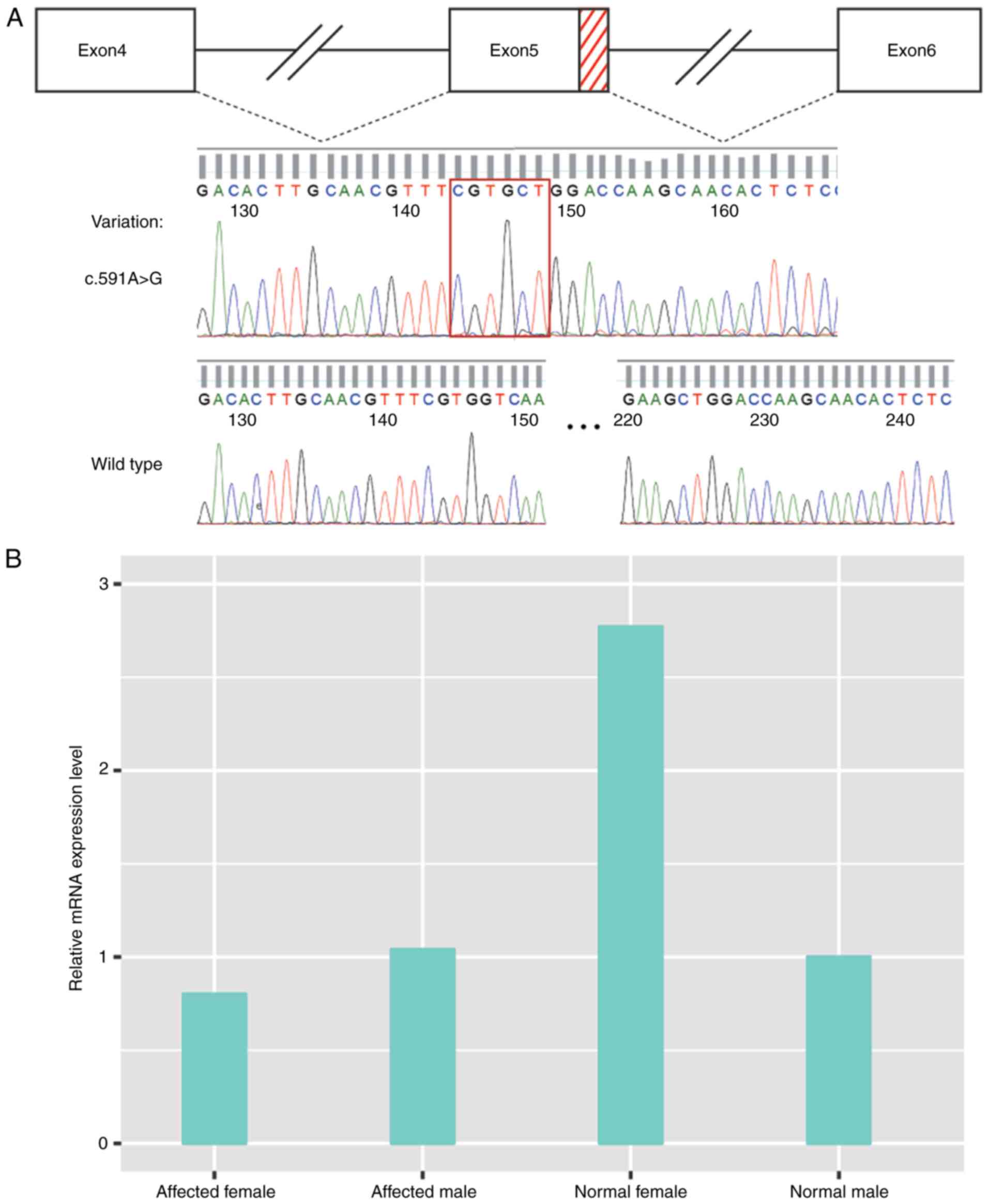|
1
|
Pavone V, Testa G, Gioitta Iachino S,
Evola FR, Avondo S and Sessa G: Hypophosphatemic rickets: Etiology,
clinical features and treatment. Eur J Orthop Surg Traumatol.
25:221–226. 2015. View Article : Google Scholar
|
|
2
|
Cho HY, Lee BH, Kang JH, Ha IS, Cheong HI
and Choi Y: A clinical and molecular genetic study of
hypophosphatemic rickets in children. Pediatr Res. 58:329–333.
2005. View Article : Google Scholar : PubMed/NCBI
|
|
3
|
Chandran M, Chng CL, Zhao Y, Bee YM, Phua
LY and Clarke BL: Novel PHEX gene mutation associated with X linked
hypophosphatemic rickets. Nephron Physiol. 116:17–218. 2010.
View Article : Google Scholar
|
|
4
|
Tenenhouse HS: X-linked hypophosphataemia:
A homologous disorder in humans and mice. Nephrol Dial Transplant.
14:333–341. 1999. View Article : Google Scholar : PubMed/NCBI
|
|
5
|
Beck-Nielsen SS, Brock-Jacobsen B, Gram J,
Brixen K and Jensen TK: Incidence and prevalence of nutritional and
hereditary rickets in southern Denmark. Eur J Endocrinol.
160:491–497. 2009. View Article : Google Scholar
|
|
6
|
Albright F, Butler AM and Bloomberg E:
Rickets resistant to vitamin d therapy. Am J Dis Child. 54:529–547.
1937.
|
|
7
|
Stickler GB and Morgenstern BZ:
Hypophosphataemic rickets: Final height and clinical symptoms in
adults. Lancet. 2:902–905. 1989. View Article : Google Scholar : PubMed/NCBI
|
|
8
|
A gene (PEX) with homologies to
endopeptidases is mutated in patients with X-linked
hypophosphatemic rickets. The HYP Consortium. Nat Genet.
11:130–136. 1995. View Article : Google Scholar : PubMed/NCBI
|
|
9
|
Filisetti D, Ostermann G, von Bredow M,
Strom T, Filler G, Ehrich J, Pannetier S, Garnier JM, Rowe P,
Francis F, et al: Non-random distribution of mutations in the PHEX
gene, and under-detected missense mutations at non-conserved
residues. Eur J Hum Genet. 7:615–619. 1999. View Article : Google Scholar : PubMed/NCBI
|
|
10
|
Guo R and Quarles LD: Cloning and
sequencing of human PEX from a bone cDNA library: Evidence for its
developmental stage-specific regulation in osteoblasts. J Bone
Miner Res. 12:1009–1017. 1997. View Article : Google Scholar : PubMed/NCBI
|
|
11
|
Lipman ML, Panda D, Bennett HP, Henderson
JE, Shane E, Shen Y, Goltzman D and Karaplis AC: Cloning of human
PEX cDNA. Expression, subcellular localization, and endopeptidase
activity. J Biol Chem. 273:13729–13737. 1998. View Article : Google Scholar : PubMed/NCBI
|
|
12
|
Du L, Desbarats M, Viel J, Glorieux FH,
Cawthorn C and Ecarot B: cDNA cloning of the murine Pex gene
implicated in X-linked hypophosphatemia and evidence for expression
in bone. Genomics. 36:22–28. 1996. View Article : Google Scholar : PubMed/NCBI
|
|
13
|
Liu S, Tang W, Fang J, Ren J, Li H, Xiao Z
and Quarles LD: Novel regulators of Fgf23 expression and
mineralization in Hyp bone. Mol Endocrinol. 23:1505–1518. 2009.
View Article : Google Scholar : PubMed/NCBI
|
|
14
|
Onishi T, Umemura S, Shintani S and
Ooshima T: Phex mutation causes overexpression of FGF23 in teeth.
Arch Oral Biol. 53:99–104. 2008. View Article : Google Scholar
|
|
15
|
Farrow EG and White KE: Recent advances in
renal phosphate handling. Nat Rev Nephrol. 6:207–217. 2010.
View Article : Google Scholar : PubMed/NCBI
|
|
16
|
Martin A, Liu S, David V, Li H, Karydis A,
Feng JQ and Quarles LD: Bone proteins PHEX and DMP1 regulate
fibro-blastic growth factor Fgf23 expression in osteocytes through
a common pathway involving FGF receptor (FGFR) signaling. FASEB J.
25:2551–2562. 2011. View Article : Google Scholar : PubMed/NCBI
|
|
17
|
Livak KJ and Schmittgen TD: Analysis of
relative gene expression data using real-time quantitative PCR and
the 2(−Delta Delta C(T)) method. Methods. 25:402–408. 2001.
View Article : Google Scholar
|
|
18
|
Mathe E, Olivier M, Kato S, Ishioka C,
Hainaut P and Tavtigian SV: Computational approaches for predicting
the biological effect of p53 missense mutations: A comparison of
three sequence analysis based methods. Nucleic Acids Res.
34:1317–1325. 2006. View Article : Google Scholar : PubMed/NCBI
|
|
19
|
Tavtigian SV, Deffenbaugh AM, Yin L,
Judkins T, Scholl T, Samollow PB, de Silva D, Zharkikh A and Thomas
A: Comprehensive statistical study of 452 BRCA1 missense
substitutions with classification of eight recurrent substitutions
as neutral. J Med Genet. 43:295–305. 2006. View Article : Google Scholar
|
|
20
|
ADHR Consortium: Autosomal dominant
hypophosphataemic rickets is associated with mutations in FGF23.
Nat Genet. 26:345–348. 2000. View
Article : Google Scholar : PubMed/NCBI
|
|
21
|
Lorenz-Depiereux B, Schnabel D, Tiosano D,
Häusler G and Strom TM: Loss-of-function ENPP1 mutations cause both
generalized arterial calcification of infancy and
autosomal-recessive hypophosphatemic rickets. Am J Hum Genet.
86:267–272. 2010. View Article : Google Scholar : PubMed/NCBI
|
|
22
|
Feng JQ, Ward LM, Liu S, Lu Y, Xie Y, Yuan
B, Yu X, Rauch F, Davis SI, Zhang S, et al: Loss of DMP1 causes
rickets and osteomalacia and identifies a role for osteocytes in
mineral metabolism. Nat Genet. 38:1310–1315. 2006. View Article : Google Scholar : PubMed/NCBI
|
|
23
|
Lorenz-Depiereux B, Bastepe M, Benet-Pagès
A, Amyere M, Wagenstaller J, Müller-Barth U, Badenhoop K, Kaiser
SM, Rittmaster RS, Shlossberg AH, et al: DMP1 mutations in
autosomal recessive hypophosphatemia implicate a bone matrix
protein in the regulation of phosphate homeostasis. Nat Genet.
38:1248–1250. 2006. View
Article : Google Scholar : PubMed/NCBI
|
|
24
|
Beck-Nielsen SS, Brixen K, Gram J and
Brusgaard K: Mutational analysis of PHEX, FGF23, DMP1, SLC34A3 and
CLCN5 in patients with hypophosphatemic rickets. J Hum Genet.
57:453–458. 2012. View Article : Google Scholar : PubMed/NCBI
|
|
25
|
Econs MJ and Francis F: Positional cloning
of the PEX gene: New insights into the pathophysiology of X-linked
hypophosphatemic rickets. Am J Physiol. 273:F489–F498.
1997.PubMed/NCBI
|
|
26
|
Grantham R: Amino acid difference formula
to help explain protein evolution. Science. 185:862–864. 1974.
View Article : Google Scholar : PubMed/NCBI
|
|
27
|
Subramanian S and Kumar S: Evolutionary
anatomies of positions and types of disease-associated and neutral
amino acid mutations in the human genome. BMC Genomics. 7:3062006.
View Article : Google Scholar : PubMed/NCBI
|
|
28
|
Goji K, Ozaki K, Sadewa AH, Nishio H and
Matsuo M: Somatic and germline mosaicism for a mutation of the PHEX
gene can lead to genetic transmission of X-linked hypophosphatemic
rickets that mimics an autosomal dominant trait. J Clin Endocrinol
Metab. 91:365–370. 2006. View Article : Google Scholar
|
|
29
|
Wang ET, Sandberg R, Luo S, Khrebtukova I,
Zhang L, Mayr C, Kingsmore SF, Schroth GP and Burge CB: Alternative
isoform regulation in human tissue transcriptomes. Nature.
456:470–476. 2008. View Article : Google Scholar : PubMed/NCBI
|
|
30
|
Ward AJ and Cooper TA: The pathobiology of
splicing. J Pathol. 220:152–163. 2010.
|
|
31
|
Wahl MC, Will CL and Lührmann R: The
spliceosome: Design principles of a dynamic RNP machine. Cell.
136:701–718. 2009. View Article : Google Scholar : PubMed/NCBI
|
|
32
|
Wang Z and Burge CB: Splicing regulation:
From a parts list of regulatory elements to an integrated splicing
code. RNA. 14:802–813. 2008. View Article : Google Scholar : PubMed/NCBI
|
|
33
|
Yeo G and Burge CB: Maximum entropy
modeling of short sequence motifs with applications to RNA splicing
signals. J Comput Biol. 11:377–394. 2004. View Article : Google Scholar : PubMed/NCBI
|
|
34
|
Krawczak M, Reiss J and Cooper DN: The
mutational spectrum of single base-pair substitutions in mRNA
splice junctions of human genes: Causes and consequences. Hum
Genet. 90:41–54. 1992. View Article : Google Scholar : PubMed/NCBI
|
|
35
|
Carpenter TO, Imel EA, Holm IA, Jan de
Beur SM and Insogna KL: A clinician's guide to X-linked
hypophosphatemia. J Bone Miner Res. 26:1381–1388. 2011. View Article : Google Scholar : PubMed/NCBI
|



